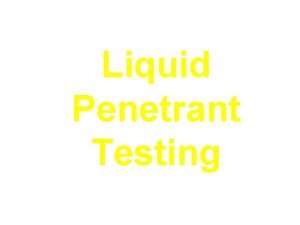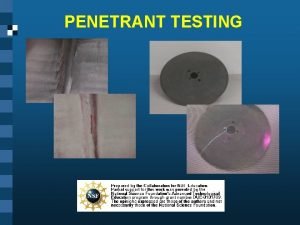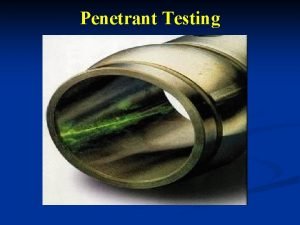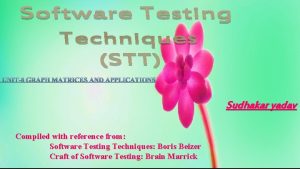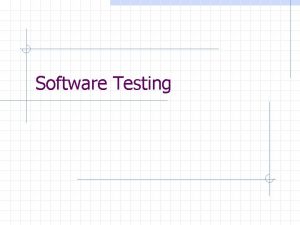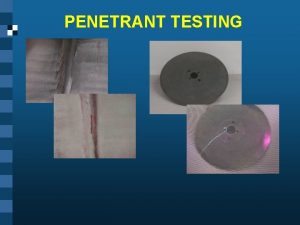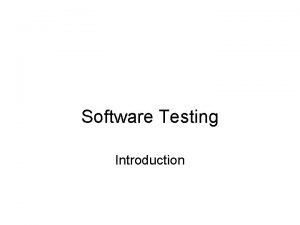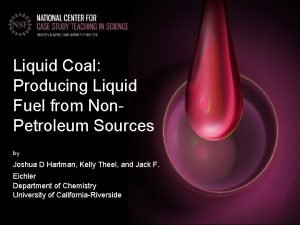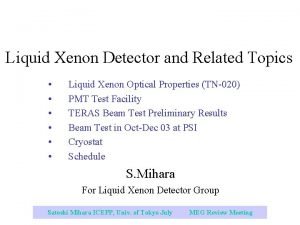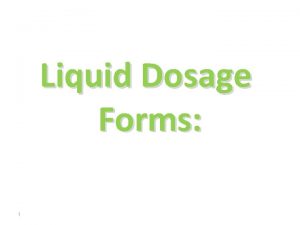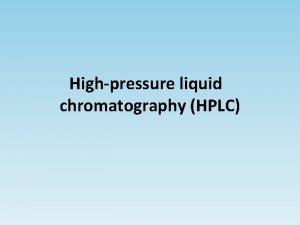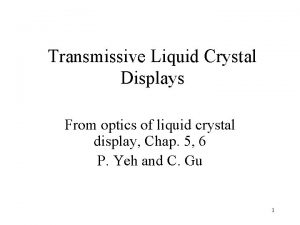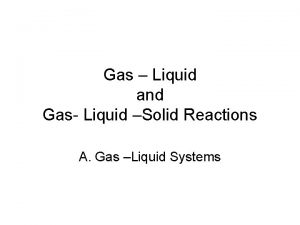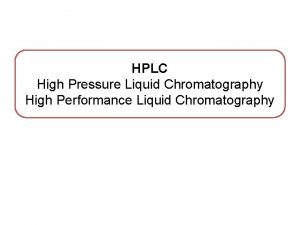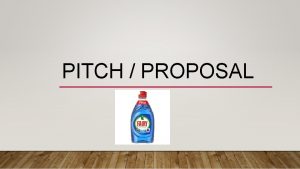Liquid Penetrant Testing Liquid Penetrant Testing Overview of





















- Slides: 21

Liquid Penetrant Testing

Liquid Penetrant Testing Overview of Liquid Penetrant Testing (PT): § What is PT? § How is PT Performed? § PT Processes § Advantages/Disadvantages § Safety Precautions § Certification Requirements Definition: An NDT method that is used to reveal surface breaking flaws through bleed out of a colored or fluorescent dye from the flaw. • One of the oldest and most widely used NDT methods • Can be used on metals and nonmetals, including glass, rubber, plastics, ceramics, etc.

Liquid Penetrant Testing PT provides a means of: • Obtaining a visual image of a discontinuity on the surface of the specimen under examination • Disclosing the nature of the discontinuity without impairing the material (presence of cracks, porosity, etc. ) • Separating acceptable and unacceptable parts in accordance with predetermined standards (the standards are included as “acceptance criteria” within a test procedure)

Liquid Penetrant Testing Types of Indications • False indications – due to inadequate removal of penetrant during rinse process or contamination from work area or hands – MUST RETEST • Nonrelevant indications – caused by actual surface discontinuities that are present by design (raised lettering to identify part, etc. ) • Relevant indications – true, unintended, discontinuities that must be interpreted and evaluated

Liquid Penetrant Testing How Does PT Work? • Based upon capillarity or capillary action – The tendency of liquids to penetrate or migrate into small openings, such as cracks, pits, or fissures • Capillarity depends on forces of cohesion, adhesion, surface tension, and viscosity – Cohesion – holds like molecules together • permits water to rise in a straw – Adhesion – causes two different substances to join • permits water to spread out over glass

Liquid Penetrant Testing More Definitions • Surface tension – enables a liquid surface to behave like a thin elastic membrane – why small bugs can stand on water – why water droplets are spherical • Viscosity – resistance of a substance to flow – honey is very viscous, alcohol is not • Liquid penetrants tend to have low surface tension (do not bead up) and high capillarity

Liquid Penetrant Testing History of PT • Used on glazed pottery to check for cracks • Railroad industry – “oil and whiting” method – Later largely replaced by magnetic particle inspection • Magnaflux in Chicago and Switzer in Cleveland performed early research in PT – Magnaflux introduced Zyglo in 1942 – first use of fluorescent dyes

Liquid Penetrant Testing Steps for Performing a PT 1) Surface Preparation • Surface must be free of paint, oil, grease, water, or other contaminants • May require etching 2) Penetrant Application • Can be done by spraying, brushing, or immersion in a penetrant bath (dip) • Penetrant must be allowed to “dwell” for a minimum time period Ø Dwell time gives penetrant time to be drawn into a discontinuity Ø Time specified by penetrant manufacturer or procedure

Liquid Penetrant Testing Steps for Performing a PT Continued 3) Excess Penetrant Removal • Penetrant to be removed from the surface of the part without removing penetrant from discontinuities 4) Developer Application • Developer acts as a blotter to draw the penetrant back to the surface of the part so it can be seen • Either a dry powder, dip, or spray • Also given time to process (usually a minimum of 10 minutes)

Liquid Penetrant Testing Steps for Performing a PT Continued 5) Inspection • Part is visually inspected under appropriate lighting to detect indications of flaws 6) Final Surface Cleaning • Required to remove developer and penetrant from the part

Liquid Penetrant Testing Categorization of PT Processes • Categorized by type of dye they contain • Type 1 – fluorescent • Type 2 – visible • Can also be dual sensitivity • Classified by method for removal of excess penetrant • Method A – water-washable • Method B – post-emulsified, lipophilic (“likes oil”) • Method C – solvent-removable • Method D – post-emulsified, hydrophilic (“likes water”)

Liquid Penetrant Testing Categorization of PT Processes Continued • Finally classified on sensitivity of the penetrant • Level ½ - Ultra Low • Level 1 – Low • Level 2 – Medium • Level 3 – High • Level 4 – Ultra High Sensitivity – the smallest defect that can be detected with a high degree of reliability

Liquid Penetrant Testing Process Selection • Depends on sensitivity required (how small are the suspected cracks? ) • Number of articles to be tested (can products be dipped? ) • Surface condition of the part (rough or smooth) • Configuration of test specimen (overhead? ) • Specific test conditions (availability of water, compressed air, etc. )

Liquid Penetrant Testing Equipment/Materials • Pre-Cleaning/Post-Cleaning – Pre-cleaning needed for effective PT (part must be dry) – Post-cleaning needed to avoid detrimental effect on part when placed in service – Rust, scale, or paint may need to be removed, or etching performed – Avoid using wire brushes or metal scrapers – they may cover up discontinuities by smearing metal, thus requiring need for etching • Stationary vs. Portable Test Equipment • Black Light - Uses filter that passes only certain wavelengths of light that activate the fluorescent material (and block harmful UV radiation)

Liquid Penetrant Testing Advantages of PT as an NDT Method • High sensitivity to small surface discontinuities • Few material limitations • Large areas and large volumes of parts can be inspected rapidly and at low cost • Can inspect parts with complex geometric shapes • Indications produced directly on surface of part for visual representation of flaw • Portable method • Relatively inexpensive

Liquid Penetrant Testing Disadvantages of PT as an NDT Method • Can only detect discontinuities that are open to the surface • Can only inspect parts with nonporous surfaces • Must pre-clean/post-clean parts • Inspector must have direct access to the part surface • Time-consuming

Liquid Penetrant Testing Benefits of PT Over VT • Defects are easier to see because flaw indication much larger than flaw itself – Threshold of human visual acuity is ~0. 00349” from a distance of 12” (for a person with 20/20 vision) • Produces a flaw indication with a high contrast – High contrast means the flaws are more readily visible against the background due to colored or fluorescent dye

Liquid Penetrant Testing Lighting Requirements • Visible penetrant – Can use natural or artificial light (white light if possible) – 100 foot candles at surface of part • Fluorescent penetrant – Usually specifies a UV light intensity of 1000 μW/cm 2 at 15” from filter face – White light must be less than 2 fc at surface

Liquid Penetrant Testing Probability of Detection Abbreviated P. O. D. – Curves available that indicate POD for specific test methods vs. size of discontinuity (such as crack length) PT better at detecting: Ø Small round defects than small linear defects Ø Deeper flaws than shallow flaws

Liquid Penetrant Testing Safety Precautions • Flammability – Use exhaust fans to disperse vapors – Ignition sources must be avoided • Skin Irritation – Wear gloves to protect hands – Wear safety glasses to protect eyes from splashing • UV Light – Lamps get hot – be cautious! – Report missing or cracked filter on lamps Ø UV rays can cause sunburn and eye damage if filters not used or not functional

Liquid Penetrant Testing Certification Requirements • Per ASNT Recommended Practice No. SNT-TC-1 A, 2011 edition: Certification Level High School Graduate or Equivalent (hrs) Two Years of Engineering or Technical School (hrs) OJT (hours) I 4 4 70 II 8 4 140 Totals: 12 8 210
 Importance of ndt
Importance of ndt Dye penetrant testing steps
Dye penetrant testing steps Properties of penetrant
Properties of penetrant Building tools of graph matrices
Building tools of graph matrices Logic based testing
Logic based testing Definition of software testing
Definition of software testing Stressed oil volume theory is applicable when
Stressed oil volume theory is applicable when Lever arm rule liquid-liquid extraction
Lever arm rule liquid-liquid extraction Anuj magazine
Anuj magazine Software domain examples
Software domain examples What is decision table testing
What is decision table testing Data flow testing strategies in software testing
Data flow testing strategies in software testing Rigorous testing in software testing
Rigorous testing in software testing Functional testing vs unit testing
Functional testing vs unit testing Pengertian black box testing
Pengertian black box testing Positive testing and negative testing
Positive testing and negative testing Testing blindness in software testing
Testing blindness in software testing Control structure testing in software testing
Control structure testing in software testing What is testing
What is testing Behavior testing adalah
Behavior testing adalah Cs3250
Cs3250 Component testing is a black box testing
Component testing is a black box testing
